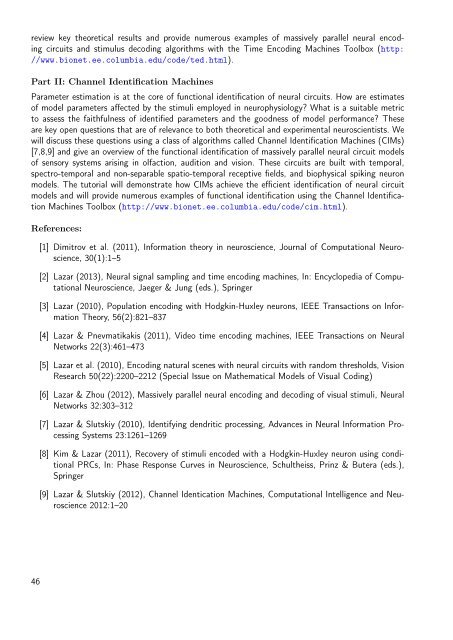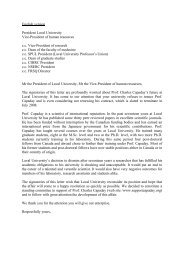Untitled - Laboratory of Neurophysics and Physiology
Untitled - Laboratory of Neurophysics and Physiology
Untitled - Laboratory of Neurophysics and Physiology
Create successful ePaper yourself
Turn your PDF publications into a flip-book with our unique Google optimized e-Paper software.
eview key theoretical results <strong>and</strong> provide numerous examples <strong>of</strong> massively parallel neural encoding<br />
circuits <strong>and</strong> stimulus decoding algorithms with the Time Encoding Machines Toolbox (http:<br />
//www.bionet.ee.columbia.edu/code/ted.html).<br />
Part II: Channel Identification Machines<br />
Parameter estimation is at the core <strong>of</strong> functional identification <strong>of</strong> neural circuits. How are estimates<br />
<strong>of</strong> model parameters affected by the stimuli employed in neurophysiology What is a suitable metric<br />
to assess the faithfulness <strong>of</strong> identified parameters <strong>and</strong> the goodness <strong>of</strong> model performance These<br />
are key open questions that are <strong>of</strong> relevance to both theoretical <strong>and</strong> experimental neuroscientists. We<br />
will discuss these questions using a class <strong>of</strong> algorithms called Channel Identification Machines (CIMs)<br />
[7,8,9] <strong>and</strong> give an overview <strong>of</strong> the functional identification <strong>of</strong> massively parallel neural circuit models<br />
<strong>of</strong> sensory systems arising in olfaction, audition <strong>and</strong> vision. These circuits are built with temporal,<br />
spectro-temporal <strong>and</strong> non-separable spatio-temporal receptive fields, <strong>and</strong> biophysical spiking neuron<br />
models. The tutorial will demonstrate how CIMs achieve the efficient identification <strong>of</strong> neural circuit<br />
models <strong>and</strong> will provide numerous examples <strong>of</strong> functional identification using the Channel Identification<br />
Machines Toolbox (http://www.bionet.ee.columbia.edu/code/cim.html).<br />
References:<br />
[1] Dimitrov et al. (2011), Information theory in neuroscience, Journal <strong>of</strong> Computational Neuroscience,<br />
30(1):1–5<br />
[2] Lazar (2013), Neural signal sampling <strong>and</strong> time encoding machines, In: Encyclopedia <strong>of</strong> Computational<br />
Neuroscience, Jaeger & Jung (eds.), Springer<br />
[3] Lazar (2010), Population encoding with Hodgkin-Huxley neurons, IEEE Transactions on Information<br />
Theory, 56(2):821–837<br />
[4] Lazar & Pnevmatikakis (2011), Video time encoding machines, IEEE Transactions on Neural<br />
Networks 22(3):461–473<br />
[5] Lazar et al. (2010), Encoding natural scenes with neural circuits with r<strong>and</strong>om thresholds, Vision<br />
Research 50(22):2200–2212 (Special Issue on Mathematical Models <strong>of</strong> Visual Coding)<br />
[6] Lazar & Zhou (2012), Massively parallel neural encoding <strong>and</strong> decoding <strong>of</strong> visual stimuli, Neural<br />
Networks 32:303–312<br />
[7] Lazar & Slutskiy (2010), Identifying dendritic processing, Advances in Neural Information Processing<br />
Systems 23:1261–1269<br />
[8] Kim & Lazar (2011), Recovery <strong>of</strong> stimuli encoded with a Hodgkin-Huxley neuron using conditional<br />
PRCs, In: Phase Response Curves in Neuroscience, Schultheiss, Prinz & Butera (eds.),<br />
Springer<br />
[9] Lazar & Slutskiy (2012), Channel Identication Machines, Computational Intelligence <strong>and</strong> Neuroscience<br />
2012:1–20<br />
46



